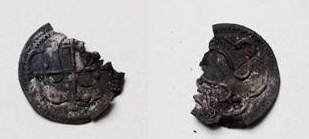VHM0350 X021
Penning korstype Dansk
Harald Blåtand år 975 - 985 kombinationsgruppe 10
Muligt præget Fyn/Sjælland/Skåne

VHM0350 X023
Penning korstype Dansk
Harald Blåtand år 975 - 985 kombinationsgruppe 11
Muligt præget Fyn/Sjælland/Skåne
VHM0350 X024
Penning korstype Dansk
Harald Blåtand år 975 - 985 kombinationsgruppe 10
Muligt præget Fyn/Sjælland/Skåne
VHM0350 X025
Penning korstype Dansk
Harald Blåtand år 975 - 985 kombinationsgruppe 10
Muligt præget Fyn/Sjælland/Skåne
VHM0350 X046
Penning korstype Dansk
Harald Blåtand år 975 - 985 kombinationsgruppe 10
Muligt præget Fyn/Sjælland/Skåne
VHM0350 X050
Penning korstype Dansk
Harald Blåtand år 975 - 985 kombinationsgruppe 10
Muligt præget Fyn/Sjælland/Skåne
VHM0350 X051
Penning korstype Dansk
Harald Blåtand år 975 - 985 kombinationsgruppe 11
Muligt præget Fyn/Sjælland/Skåne
VHM0350 X052
Penning korstype Dansk
Harald Blåtand år 975 - 985 kombinationsgruppe 11
Muligt præget Fyn/Sjælland/Skåne
VHM0350 X058
Penning korstype Dansk
Harald Blåtand år 975 - 985 kombinationsgruppe 10
Muligt præget Fyn/Sjælland/Skåne
VHM0350 X061
Penning korstype Dansk
Harald Blåtand år 975 - 985 kombinationsgruppe 10
Muligt præget Fyn/Sjælland/Skåne
VHM0350 X062
Penning korstype Dansk
Harald Blåtand år 975 - 985 kombinationsgruppe 10
Muligt præget Fyn/Sjælland/Skåne

VHM0350 X067
Penning korstype Dansk
Harald Blåtand år 975 - 985 kombinationsgruppe 10
Muligt præget Fyn/Sjælland/Skåne
VHM0350 X068
Penning korstype Dansk
Harald Blåtand år 975 - 985 kombinationsgruppe 10
Muligt præget Fyn/Sjælland/Skåne
VHM0350 X070
Penning korstype Dansk
Harald Blåtand år 975 - 985 kombinationsgruppe 11
Muligt præget Fyn/Sjælland/Skåne
VHM0350 X071
Penning Dansk Harald Blåtand år 975 -
Præget i Hedeby
Yngre Karolingisk typ, Kombinationsgrupp 9b
VHM0350 X075
Penning korstype Dansk
Harald Blåtand år 975 - 985 kombinationsgruppe 10
Muligt præget Fyn/Sjælland/Skåne
VHM0350 X077
Penning korstype Dansk
Harald Blåtand år 975 - 985 kombinationsgruppe 10
Muligt præget Fyn/Sjælland/Skåne
VMH0350 X105
Penning korstype Dansk
Harald Blåtand år 975 - 980 kombinationsgruppe 11
Muligt præget Fyn/Sjælland/Skåne
VHM0350 X111
Penning Yngre Karolingisk type
Harald Blåtand ca år 975
Kombinationsgrupp 9b
Præget i Hedeby
VHM0350 X116
Penning korstype Dansk
Harald Blåtand år 975 - 980 kombinationsgruppe 11
Muligt præget Fyn/Sjælland/Skåne
VHM0350 X117
Penning korstype Dansk
Harald Blåtand år 975 - 985 kombinationsgruppe 10
Muligt præget Fyn/Sjælland/Skåne
VHM0350 X132
Penning Yngre Karolingisk type
Harald Blåtand ca år 975
Kombinationsgrupp 9b-d
Præget i Hedeby
VHM0350 X135
Penning Yngre Karolingisk type
Harald Blåtand ca år 975
Kombinationsgrupp 9b
Præget i Hedeby
VHM0350 X137
Penning Yngre Karolingisk type
Harald Blåtand ca år 975
Kombinationsgrupp 9b-d
Præget i Hedeby
VHM0350 X140
Penning korstype Dansk
Harald Blåtand år 975 - 985 kombinationsgruppe 10
Muligt præget Fyn/Sjælland/Skåne
VHM0350 X149
Penning korstype Dansk
Harald Blåtand år 975 - 985 kombinationsgruppe 10 eller 11
Muligt præget Fyn/Sjælland/Skåne
VHM0350 X156
Penning korstype Dansk
Harald Blåtand år 975 - 985 kombinationsgruppe 10
Muligt præget Fyn/Sjælland/Skåne
VHM0350 X169
Penning korstype Dansk
Harald Blåtand år 975 - 985 kombinationsgruppe 10
Muligt præget Fyn/Sjælland/Skåne
VHM0350 X188
Penning korstype Dansk
Harald Blåtand år 975 - 985 kombinationsgruppe 10
Muligt præget Fyn/Sjælland/Skåne
VHM0350 X198
Penning korstype Dansk
Harald Blåtand år 975 - 985 kombinationsgruppe 10
Muligt præget Fyn/Sjælland/Skåne
VHM0350 X199
Penning korstype Dansk
Harald Blåtand år 975 - 985 kombinationsgruppe 10 eller 11
Muligt præget Fyn/Sjælland/Skåne
VHM0350 X201
Penning korstype Dansk
Harald Blåtand år 975 - 985 kombinationsgruppe 10
Muligt præget Fyn/Sjælland/Skåne
VHM0350 X205
Penning korstype Dansk
Harald Blåtand år 975 - 985 kombinationsgruppe 10
Muligt præget Fyn/Sjælland/Skåne
VHM0350 X206
Penning korstype Dansk
Harald Blåtand år 975 - 985 kombinationsgruppe 10
Muligt præget Fyn/Sjælland/Skåne
VHM0350 X208
Penning korstype Dansk
Harald Blåtand år 975 - 985 kombinationsgruppe 10
Muligt præget Fyn/Sjælland/Skåne
VHM0350 X210
Penning korstype Dansk
Harald Blåtand år 975 - 985 kombinationsgruppe 10 eller 11
Muligt præget Fyn/Sjælland/Skåne
VHM0350 X213
Penning korstype Dansk
Harald Blåtand år 975 - 985 kombinationsgruppe 10
Muligt præget Fyn/Sjælland/Skåne
VHM0350 X214
Penning korstype Dansk
Harald Blåtand år 975 - 985 kombinationsgruppe 10
Muligt præget Fyn/Sjælland/Skåne
ID på ovennævnte mønter er foreslået ID, Endeligt ID følger når mønterne er færdigbehandlet af Nationalmuseets mønteksperter.